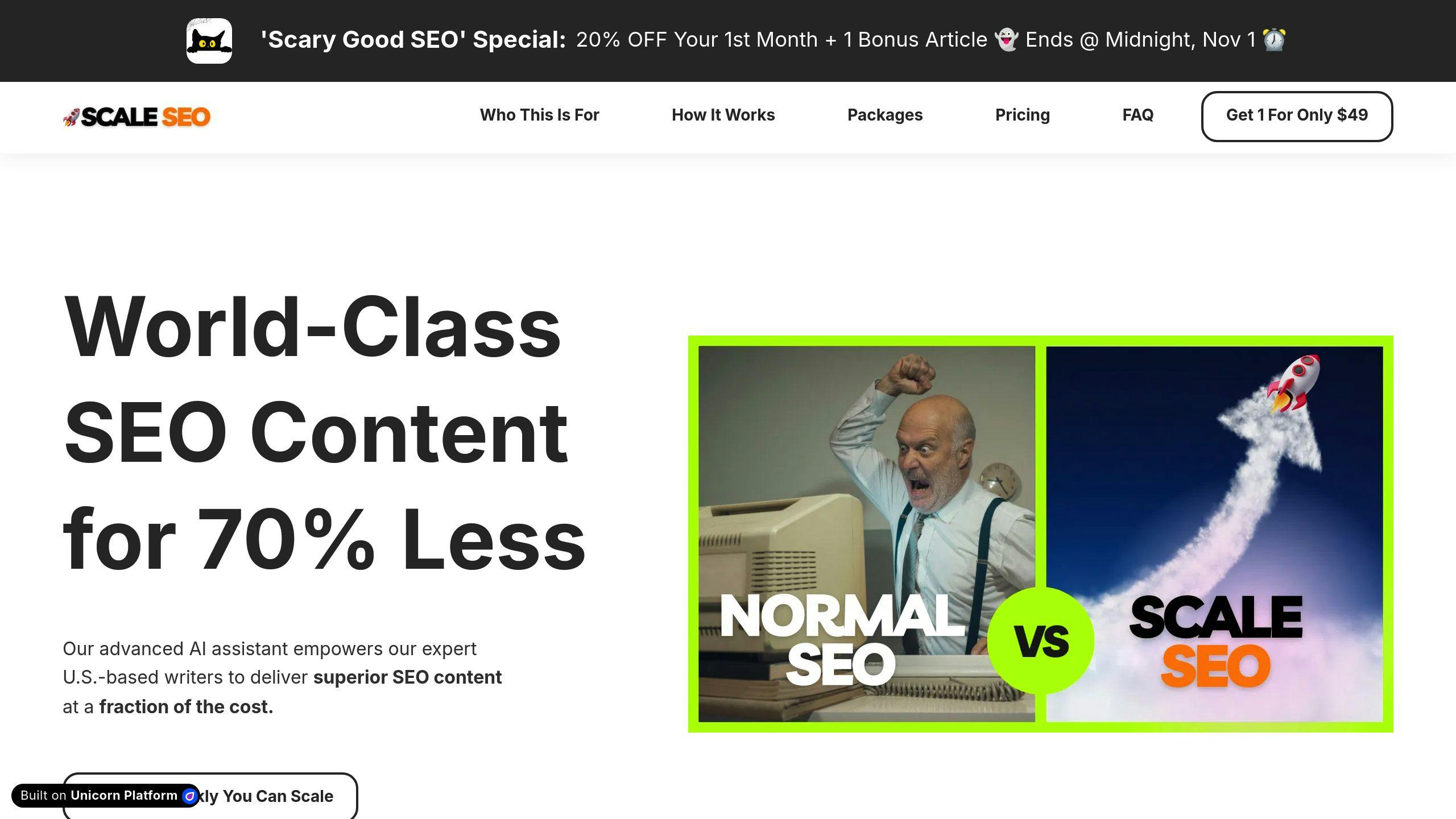Want more local customers? Here's how to create content that gets them through your door:
- Use local keywords people actually search for
- Keep your business info consistent everywhere online
- Solve real problems your local customers face
- Optimize your service pages for local searches
- Write about local events and community happenings
- Make your content mobile-friendly (82% of local searches are on phones)
- Post regularly: 16 blog posts a month, weekly Google Business Profile updates
Key stats:
- 95% of smartphone users do local searches
- 61% call a business after searching
- 59% visit a store after searching
Remember: Good local content builds trust, boosts visibility, and sparks engagement. It's not just about keywords - it's about connecting with your community.
Need help? Consider working with an SEO service to create and manage your local content strategy.
Featured Video: How to Get More Local Business Instantly
What Makes Local Content Work
Local SEO content is the secret sauce for businesses looking to shine in their community. Let's break it down.
What is Local SEO Content
It's content that speaks directly to your neighborhood audience. Think of it as a digital chat with your neighbors. You're not just selling; you're joining the community conversation.
This could include:
- Blog posts about local events
- Area-specific service pages
- Stories from local customers
- Updates on community projects you're involved in
The key? Make it hyper-relevant to your area. A Seattle coffee shop might write "5 Rainy Day Coffee Spots in Downtown Seattle" – it's specific, useful, and local.
How Local Content Brings in Customers
Good local content is like a customer magnet. Here's why:
1. It builds trust
When you show you get local needs, people trust your business more.
2. It boosts visibility
Local content helps you rank better in local searches. More eyes on you.
3. It sparks engagement
Content about local issues can get people talking and sharing. Your reach grows.
Real businesses see real results. A San Francisco barbershop updated their Google Business Profile with fresh photos, posts, and quick replies to customer questions. Result? More customer engagement and visibility. Simple, but effective.
Getting Seen in Local Searches
To pop up in local searches, your content needs to be locally optimized. That means:
- Using local keywords people actually search for
- Creating pages for each area you serve
- Optimizing for "near me" searches (these are up 136% in the last year)
Timothy Carter from SEO.co puts it well:
"Local SEO helps you reach your target audience."
It's about being found by the right people – those nearby who want what you offer.
One last thing: keep your business info (name, address, phone) the same everywhere online. It helps search engines trust you and rank you higher locally.
Must-Have Content Parts
Want to create local SEO content that actually brings customers through your door? Here's what you need to focus on:
Local Keywords That Matter
It's not just about mentioning your city name. You need to think like a local.
A Seattle coffee shop owner found that "rainy day coffee spots in Downtown Seattle" worked way better than "best coffee shop". The result? 25% more foot traffic when it rained.
How to find your local keyword gold:
- Brainstorm how locals talk about your area and services
- Use Google Keyword Planner to check search volumes
- Look at your Google Business Profile insights
Here's the kicker: Sometimes, specific local terms beat out the big, broad keywords. A Chicago dentist got more bookings from "teeth whitening in Loop Chicago" than "Chicago dentist", even though fewer people searched for it.
Keep Business Info the Same
Your Name, Address, and Phone number (NAP) need to be EXACTLY the same everywhere online. Why? Because 80% of people lose trust in a business when they see different contact details.
Take Milano Bakery in Joliet, Illinois. They're #1 for "joliet bakery" and get about 3,000 site visits a month from desktop searches. Their secret sauce? Consistent NAP info across the board.
To nail this:
- Make a master document with your exact business details
- Regularly check your online presence
- Use tools like Citation Tracker to automate consistency checks
Solve Local Customer Problems
Don't just list your services. Address what your community actually needs.
Kody Smith, a pet waste removal guy, grew his business from $26,000 to nearly $300,000 in a year. How? He created content like "How to keep your lawn clean in Seattle's rainy season" and "Dealing with pet waste in small Chicago yards".
To create content that solves problems:
- Listen to your customers' most common questions
- Check local forums and social media groups for complaints
- Create content that tackles these issues head-on, showing how you can help
sbb-itb-e98aa53
Content That Works for Local Business
Want to attract more local customers? Let's dive into two strategies that can supercharge your local business content.
Making Service Pages Better
Your service pages are your digital storefront. Here's how to make them shine:
1. Create distinct pages for each service
Don't cram everything onto one page. Give each service its own spotlight. This helps you rank for specific local searches and gives customers the details they crave.
2. Include local keywords
Sprinkle in location-specific terms naturally. If you're a Chicago dentist, try "teeth whitening in Loop Chicago" instead of just "Chicago dentist".
3. Add social proof
Show off those glowing reviews from local clients. It builds trust and shows you're part of the community.
4. Use visuals
Add photos or videos of your team in action around town. It helps potential customers picture your service and connects you to the area.
5. Optimize for voice search
People talk to their phones now. Include questions like "Where can I find the best coffee in Downtown Seattle?" in your FAQ section.
KapturePest.com saw a 40% jump in local organic traffic after revamping their service pages. They created separate pages for each pest control service, added reviews from Seattle locals, and optimized for voice search queries.
Writing About Local Events
Want to connect with your community and boost your local SEO? Get involved with local events:
1. Create an event calendar
Add a dedicated events page to your site. Make it easy to sort between upcoming and past events.
2. Write event preview articles
Tell the human side of the story. Highlight sponsors, vendors, and local volunteers to build your network.
3. Publish event recap posts
After an event, share pictures, YouTube videos, and a quick summary. Include quotes from attendees and any funny moments to keep it engaging.
4. Leverage "ego-bait"
Mention and tag local businesses and nonprofits on social media. They might share your content, expanding your reach.
5. Host your own events
Organize community events that fit your brand. Powell's Books in Portland hosts author readings and book clubs, promoting them through their blog and social media.
Cafe Allegro, a Seattle coffee shop, started writing about local music events in their neighborhood. They saw 25% more foot traffic on event days and a 15% boost in local search visibility within three months.
Writing for Local Searches
Local SEO is all about understanding how people in your area look for businesses online. Let's look at how to make your content match local search habits and shine on mobile devices.
How Local People Search
Local searches are quick and to-the-point. Here's what you need to know:
"Near me" is huge
"Near me" searches have exploded in popularity. People want to find businesses close by, right now.
Think "coffee shop near me" or "dentist open now". Make sure your content includes these kinds of local phrases.
Mobile dominates local searches
82% of smartphone users search for local businesses. And get this: 76% of those searchers visit a business within a day, with 28% making a purchase.
Your content needs to be mobile-friendly and action-packed. Use clear calls-to-action like "Visit us today" or "Call now for a quote".
Local keywords are key
People often include their city or neighborhood when searching. Don't just aim for "best pizza". Go for "best pizza in Downtown Seattle" or "Chicago deep-dish near Wrigleyville".
Shoreline Pools, a pool renovation company, nailed this approach. They created location-specific content and used local keywords. The result? 15,000 monthly blog views and 10,000 Google My Business impressions per month.
Making Content Work on Phones
Over 57% of global website traffic comes from mobile devices. You can't ignore mobile optimization. Here's how to do it right:
Keep it short and sweet
Mobile users are often in a hurry. Use short paragraphs, bullet points, and clear headings. Make it easy for users to find what they need fast.
Think voice search
More people are using voice assistants to find local businesses. Include conversational phrases in your content. For example: "Where can I find the best coffee in Downtown Seattle?"
Speed matters
A slow site can drive customers away. Compress images, speed up server response times, and use browser caching to make your mobile site zippy.
GameStop's mobile site is a great example. It loads instantly and has an easy-to-use drop-down menu. Customers can find what they need in no time.
Use local structured data
Add schema markup to your website. It helps search engines understand your local business info. This can boost how your business shows up in local search results.
Remember, Google mainly uses the mobile version of your site for ranking. As Paul Sanders from The Content Marketing Institute says:
"When consumers are using mobile devices, they are more likely to be conducting local searches, and that traffic drives leads and sales."
So, make sure your mobile game is strong. Your local SEO success depends on it.
Getting it Done
Let's break down how to create effective local SEO content and keep a steady content strategy that brings customers to your door.
Content Creation Steps
1. Research Local Keywords
Find keywords that matter to your local audience. Use tools like Semrush's Keyword Magic Tool to see how people in your area search for businesses like yours.
A coffee shop in Seattle might find that "rainy day coffee spots in Downtown Seattle" works better than just "best coffee shop".
2. Create a Content Calendar
Plan your content ahead of time. This helps you stay on top of local events, seasonal trends, and regular website updates.
3. Develop Location-Specific Pages
Make separate pages for each service or location you cover. This helps you show up in specific local searches and gives potential customers detailed info.
4. Optimize for Mobile and Voice Search
82% of smartphone users do local searches. Make sure your content works well on mobile and includes phrases people might use when speaking.
5. Add Local Elements
Mix in local landmarks, events, and community info in your content. It shows you're part of the community and helps with local SEO.
When to Post Content
Posting regularly is key for local SEO. Here's a quick guide:
- Website Blog: Try for 16 posts a month (about four times a week). B2B companies doing this get 3.5 times more traffic than those posting 0-4 times a month.
- Google Business Profile: Update at least once a week with posts about events, deals, or new products.
-
Social Media:
- Facebook: 1 post a day or 5 posts a week
- Twitter: 3-5 tweets a day
- Instagram: Once a day
- LinkedIn: 1-2 posts a day, focus on business stuff
Remember, good content beats lots of content. As one expert says: "Only post stuff that your followers will find interesting, fun, or useful."
Scale SEO: Getting Expert Help

Handling local SEO content can eat up a lot of time. That's where getting help can be smart. Scale SEO offers a full service that uses AI tech and U.S.-based writers to create top-notch, SEO-friendly articles.
They offer:
- Expert keyword research
- Content writing for your local audience
- Building links inside and outside your site
- Making images and videos work better for SEO
- Regular posting schedule
Scale SEO has plans from one article at $297/month to 28 articles at $6,340/month (24% off). They can help businesses big and small keep up a strong local content strategy.
Wrap-Up
Local SEO can make or break your business online. Here's what you need to know:
Keep your NAP consistent. Your Name, Address, and Phone number should be the same everywhere online. This helps your local search rankings.
Make the most of your Google Business Profile. Fill it out completely. Add good photos. Update it often. Businesses with photos get 42% more requests for directions and 35% more clicks to their website.
Get more reviews. They're not just nice to have - they help you rank better in local searches. Set up a system to ask happy customers for reviews.
Don't forget mobile. 76% of local searchers visit a store within a day. Make sure your site works well on phones. Think about voice search too - more people are using it now.
Create local content. Write about things that matter to your community. Share guides about local events. Team up with other local businesses to get more eyes on your content.
Keep at it. Local SEO isn't a one-time thing. As Mike Henry, CX Writer, says:
"Local SEO is one of the most important factors for driving traffic to your business."
So stay on top of it, and watch your local visibility grow.


